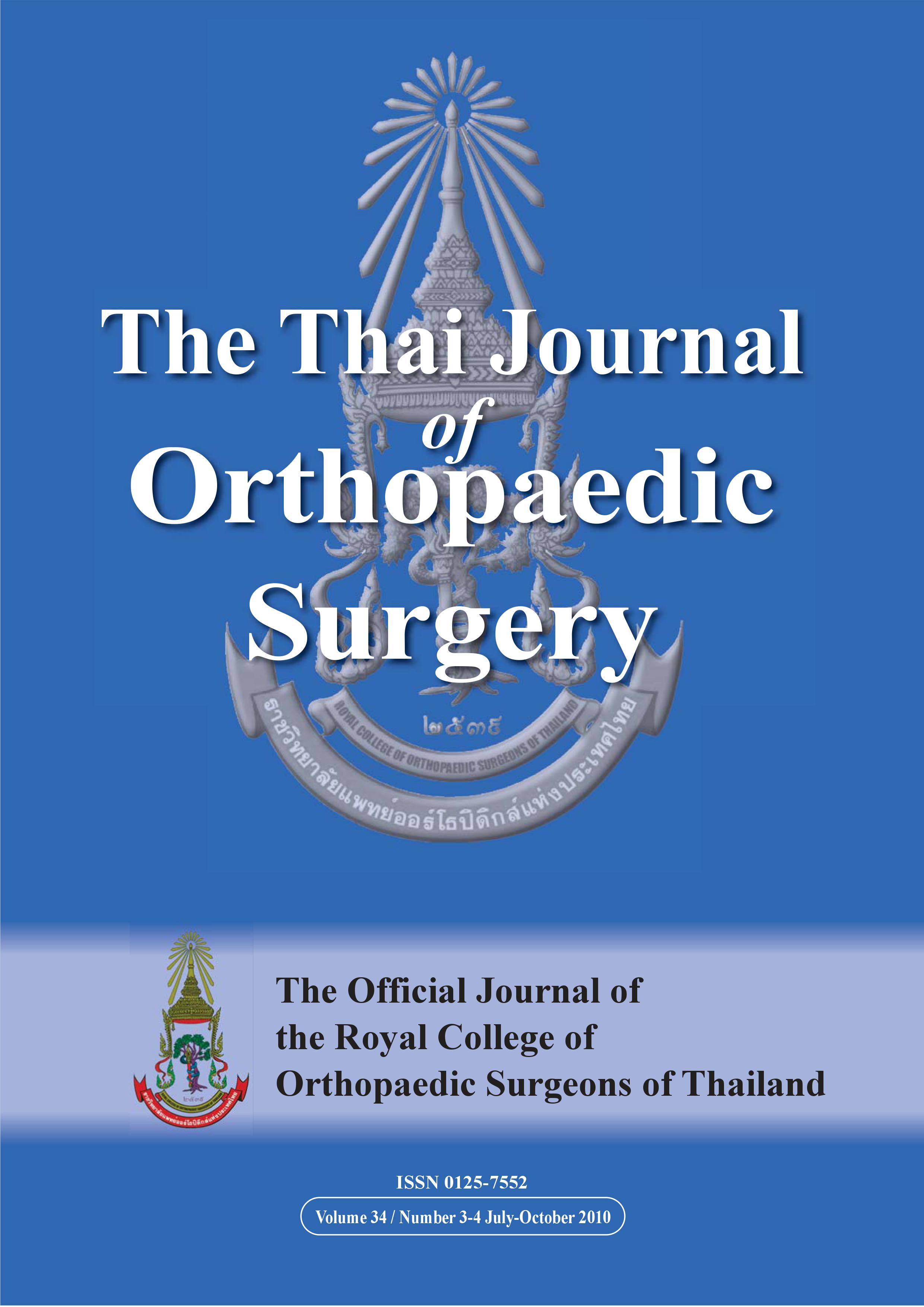การศึกษาระดับของครอสลิงค์เอ็นเทโลเป็บไทด์ของคอลลาเจนชนิดที่หนึ่งในปัสสาวะของสตรีไทยวัยเจริญพันธุ์และวัยหมดระดู
Main Article Content
บทคัดย่อ
จุดประสงค์: เพื่อเปรียบเทียบประสิทธิผลการป้องกันอาการคันจากการใส่เฝือกระหว่างแป้งฝุ่นและคาลาไมน์โลชั่นในผู้ป่วยกระดูกเรเดียสส่วนปลายหักที่รักษาด้วยการใส่เฝือกแขนสั้น
วัสดุและวิธีการ: ผู้ป่วยกระดูกเรเดียสส่วนปลายหักอายุระหว่าง 15 ถึง 80 ปีที่เข้ารักษาที่แผนกฉุกเฉิน รพ.สงขลานครินทร์ ได้รับเชิญเข้าร่วมการศึกษา แบ่งผู้ป่วยเป็น 2 กลุ่มโดยวิธีสุ่มได้แก่ แป้งฝุ่น และคาลาไมน์โลชั่น ก่อนทำการการรักษาโดยการจัดเรียงกระดูกและใส่เฝือกแขนสั้นประมาณ 4 สัปดาห์ ผู้ป่วยทุกคนได้รับยาแก้ปวดและยาลดอาการคันกลับบ้าน แพทย์นัดติดตามการรักษา สัปดาห์ที่ 1 , 2 และ 4 ผู้ป่วยได้รับหนังสือบันทึกอาการคัน โดยผู้ป่วยรายงานระดับอาการคัน (คะแนน 0-10) ทุกวันขณะใส่เผือก แพทย์ตรวจสอบสภาพผิวหนังบริเวณใต้เฝือกเมื่อผู้ป่วยได้รับการถอดเฝือก และผู้ป่วยประเมินระดับความพึงพอใจผลการรักษาเมื่อสิ้นสุดการรักษา
ผลการศึกษา: มีผู้ป่วย เข้าร่วมในการศึกษานี้ 34 รายโดย 19 รายอยู่ในกลุ่มแป้งฝุ่นและ 15 รายอยู่ในกลุ่มคาลาไมน์โลชั่น สาเหตุของอุบัติเหตุส่วนใหญ่เกิดจากการหกล้มหรืออุบัติเหตุมอเตอร์ไซค์ ไม่มีผู้ป่วยรายใดขาดการติดตามในการศึกษา ผลคะแนนเฉลี่ยระดับอาการคันของผู้ป่วยทั้ง 2 กลุ่มดีขึ้นหลังได้รับการทาแป้งฝุ่นและคาลาไมน์โลชั่น แต่ระดับคะแนนความคันเฉลี่ยของผู้ป่วยกลุ่มคาลาไมน์โลชั่นดีกว่ากลุ่มแป้งฝุ่นอย่างมีนัยสำคัญทางสถิติที่วันที่ 28 หลังการรักษา อย่างไรก็ดีปริมาณการใช้ยาเพื่อลดอาการคันและความพึงพอใจต่อการรักษาทั้งสองกลุ่มไม่แตกต่างกันอย่างมีนัยสำคัญทางสถิติ
สรุป: คาลาไมน์โลชั่นป้องกันอาการคันได้ดีกว่าแป้งฝุ่นในผู้ป่วยกระดูกเรเดียสส่วนปลายหักที่ได้รับการรักษาด้วยเฝือกแขนสั้น
Article Details
เอกสารอ้างอิง
2. Scott H, Micheal B. Early soft tissue complication after fracture distal part of radius. J Bone Joint Surg [Am]. 1993; 75: 144-153.
3. Dion M. A prospective evaluation of patient experiences and skin condition during and after cast immobilization. J Nat Ortho Tech. 2002: 1-4.
4. Wong A, Watson B. Allergic contact dermatitis due to benzalkonium chloride in plaster of Paris. Aus J Dermatol. 2001; 42: 33-35.
5. Schmelz M. A neural pathway for itch. Nat Neurosci. 2001; 4: 9-10.
6. Davies MG, Greaves MW. Sensory responses of human skin to synthetic histamine analogues and histamine. Br J Clin Pharmacol. 1980; 9: 461-465.
7. Greavas MW. Antihistamine. Dermato Clin. 2001; 19: 53-62.
8. Krause L, Shuster S. Mechanism of action of antipruritus drugs. Br Med J. 1983; 287: 1199-1200.
9. Jeffery D, Bernhard JD. Itch and pruritus: what are they and how should itches be classified?. Dermato Ther. 2005; 18: 288-291.
10. Bromm B, Scharein F, Darsow U, Ring J. Effects of menthol and cold on histamine-induced itch and skin reactions in man. Neurosci Lett. 1995; 187: 157-160.
11. Yosipovitch G, Szolar C, Hui XY, Maibach H. Effect of tropically applied menthol on thermal pain and itch sensations and biophysical properties of the skin. Arch Dermatol Res. 1996; 288: 245-248.
12. Staniforth P. Allergy to benzalkonium chloride in plaster of Paris after sensitization to cetrimide. J Bone Joint Surg [Am]. 1980; 62: 42:44.
13. Sawai J. Quantitative evaluation of antibacterial activities of metallic oxide powders (ZnO, MgO and CaO) by conductimetric assay. J Microbio Methods. 2003; 54: 177-182.
14. Misery L. Randomized controlled trial of a calamine-containing gel versus excipient in the treatment of idiopathic anal pruritus. Neuro Dermatol. 2004; 23: 7-9.


